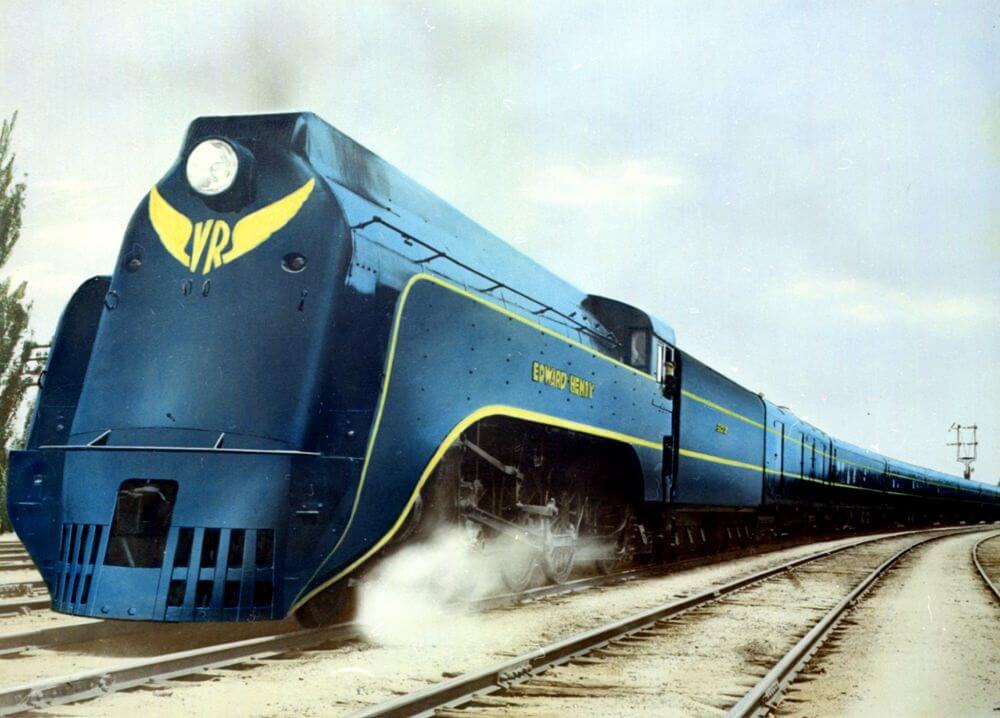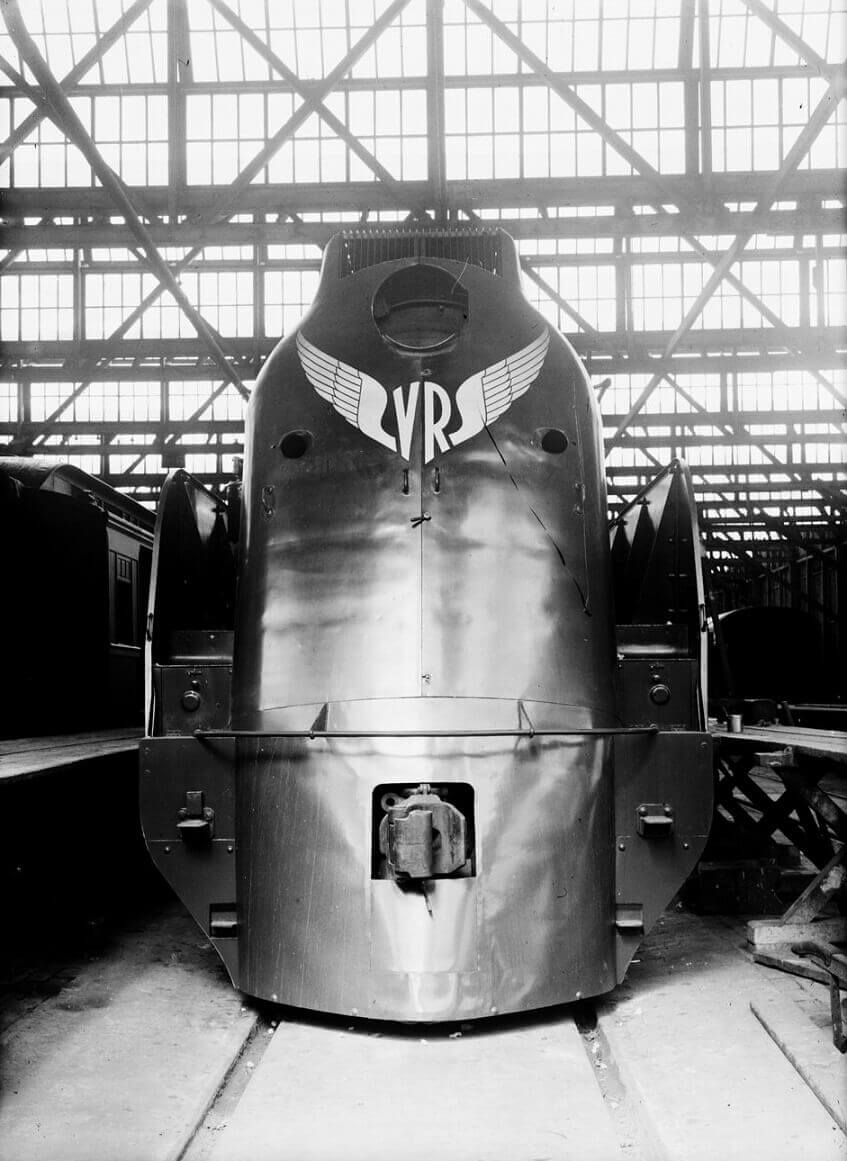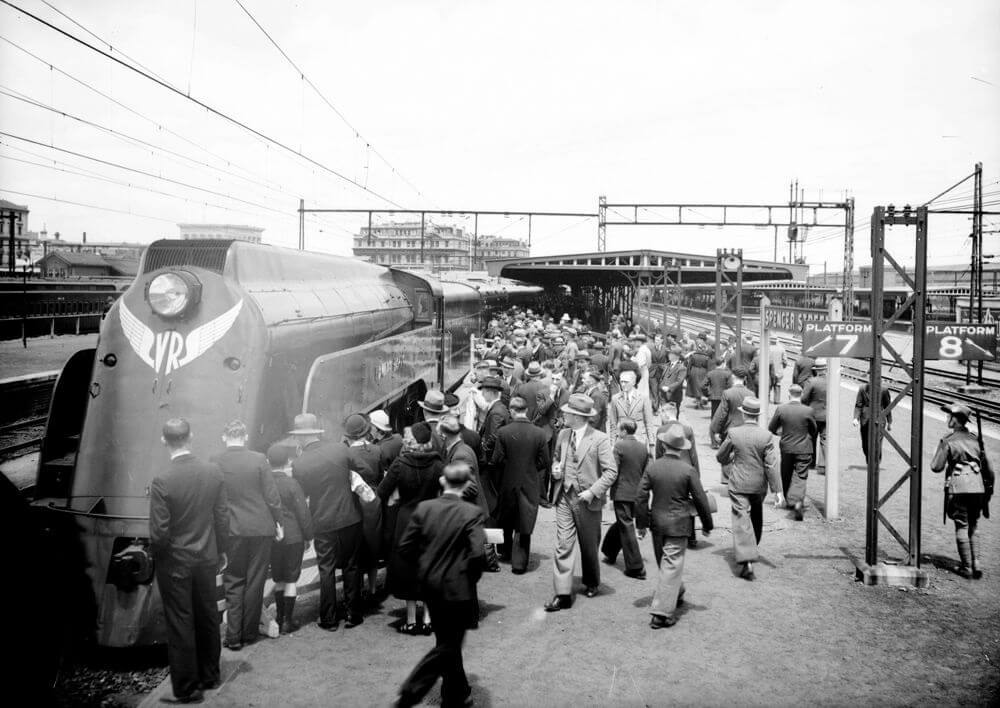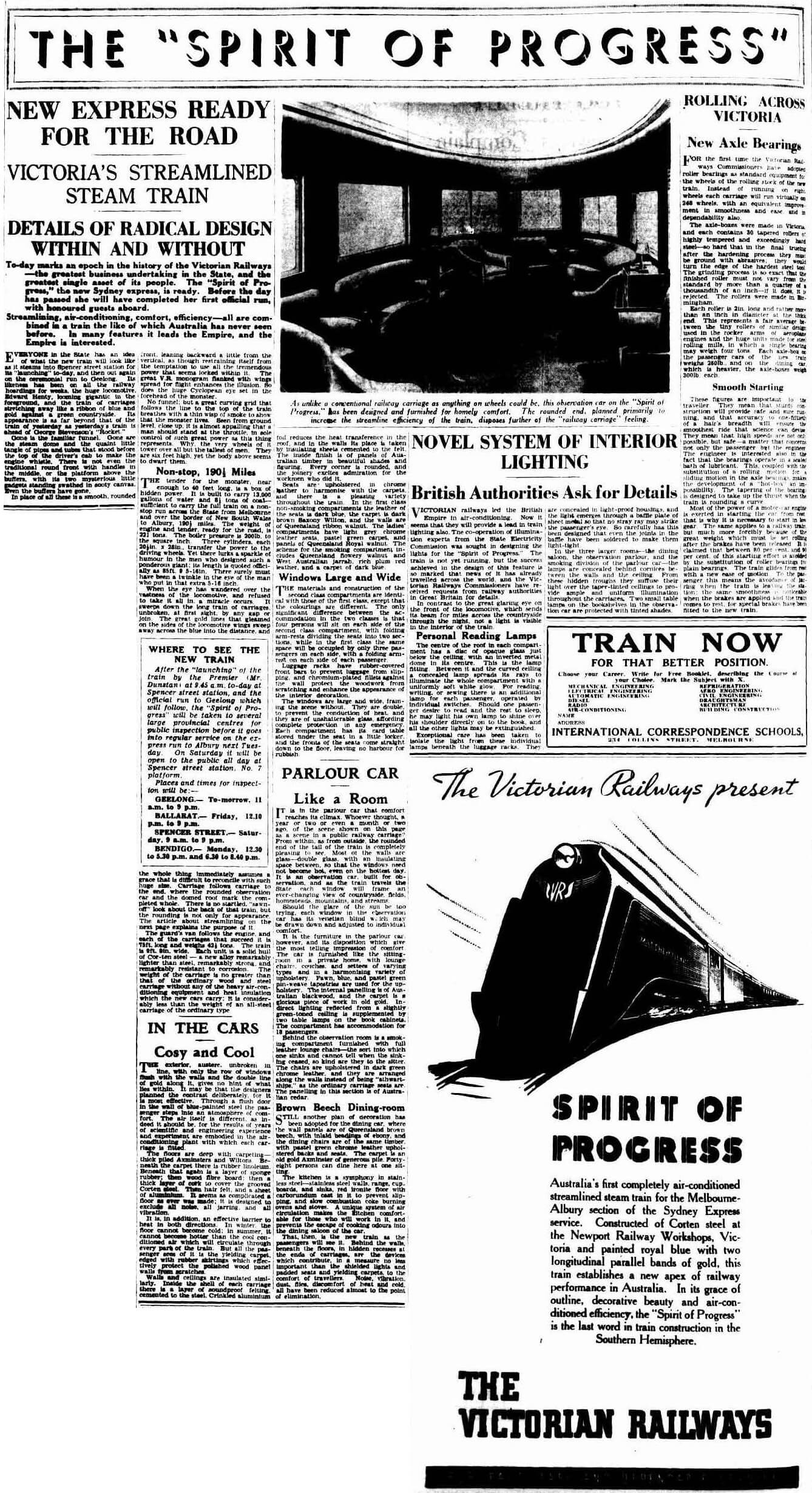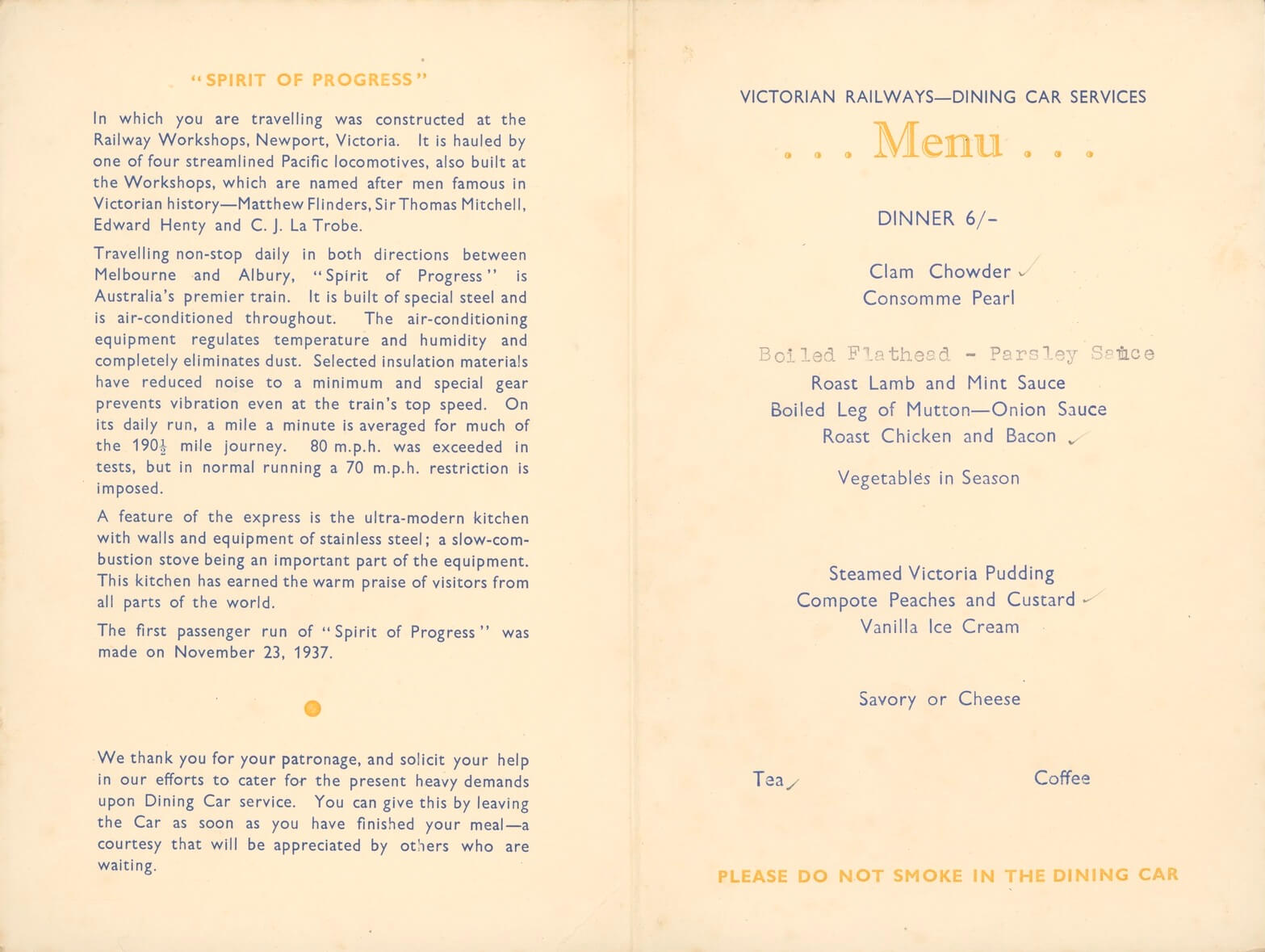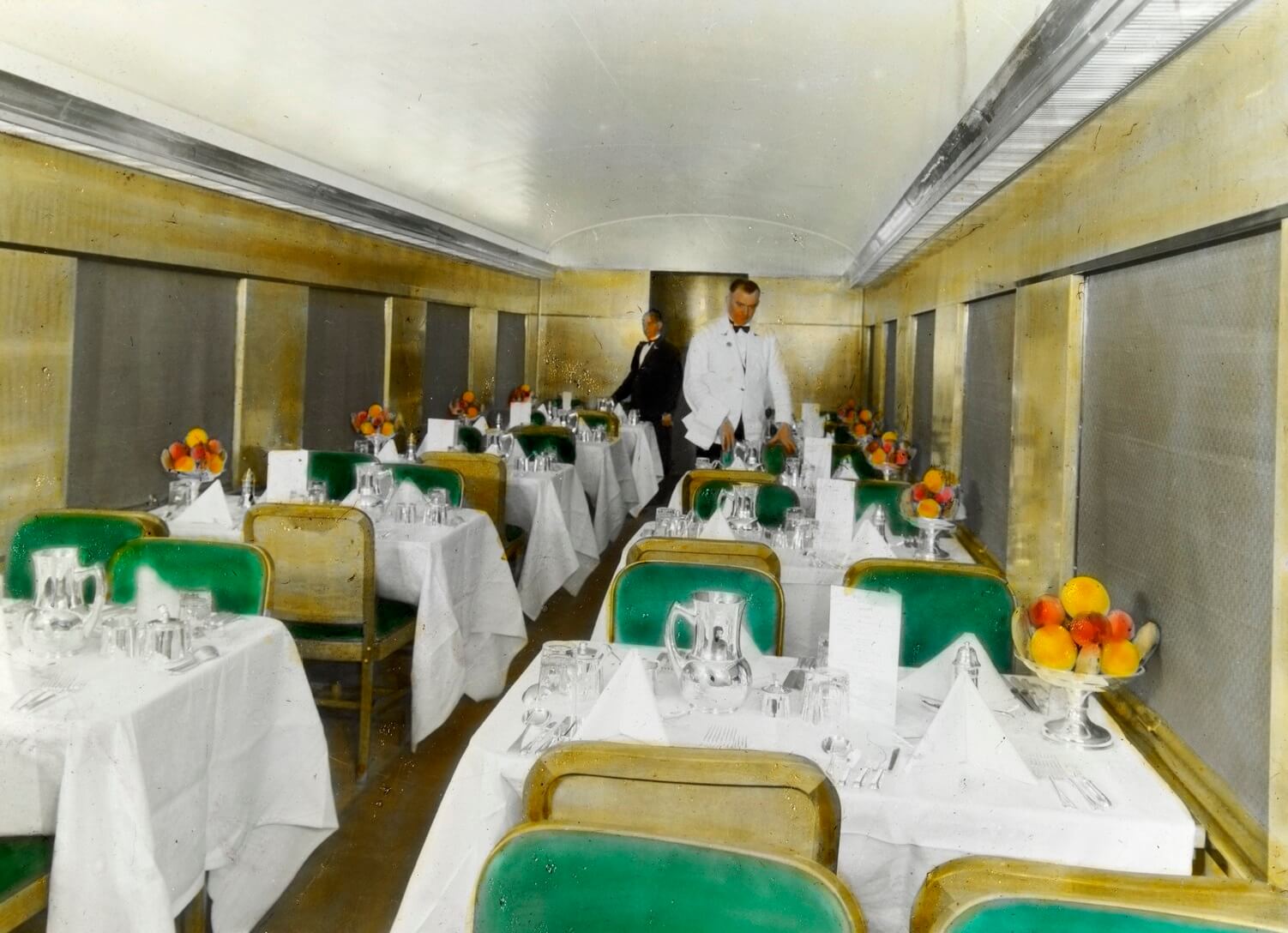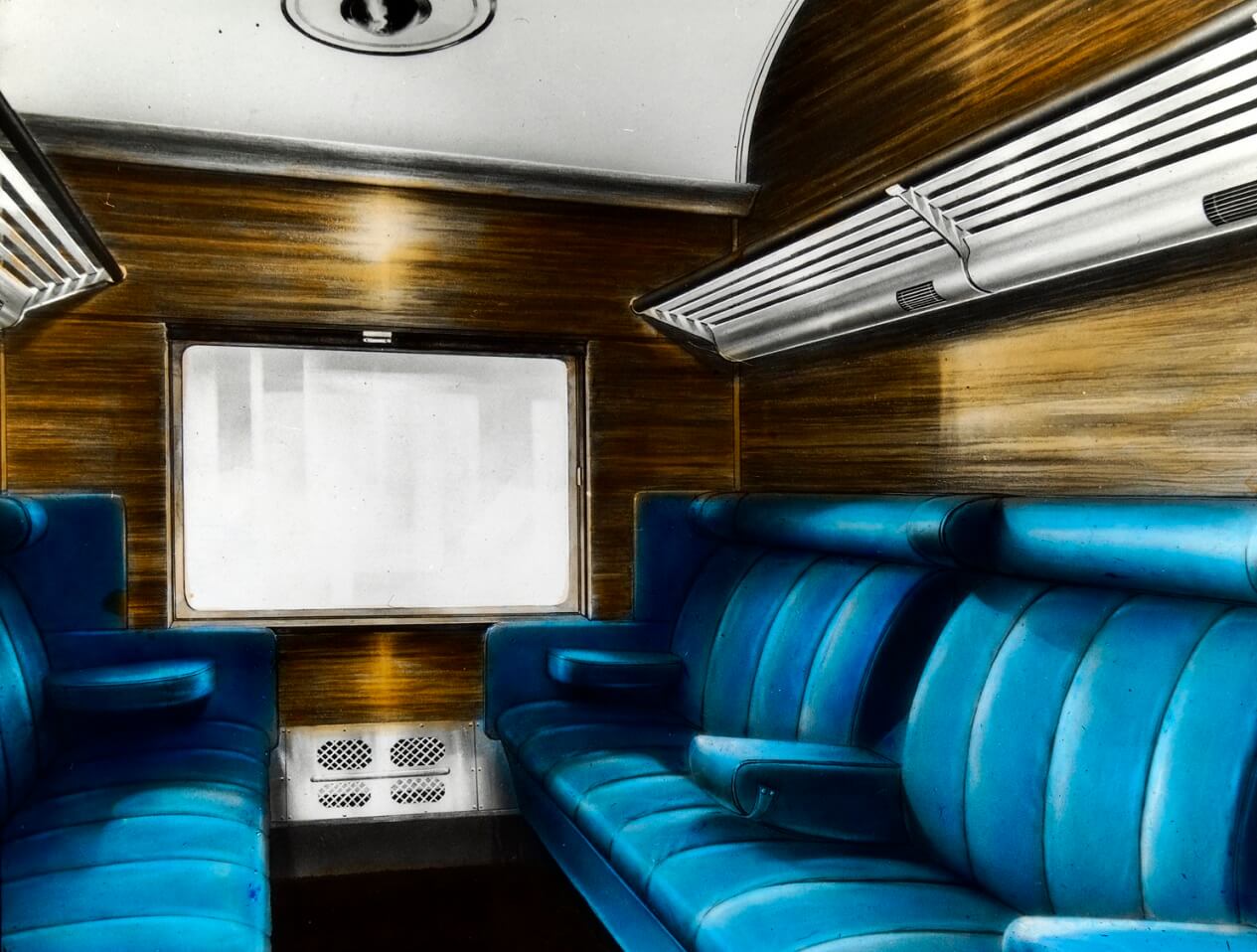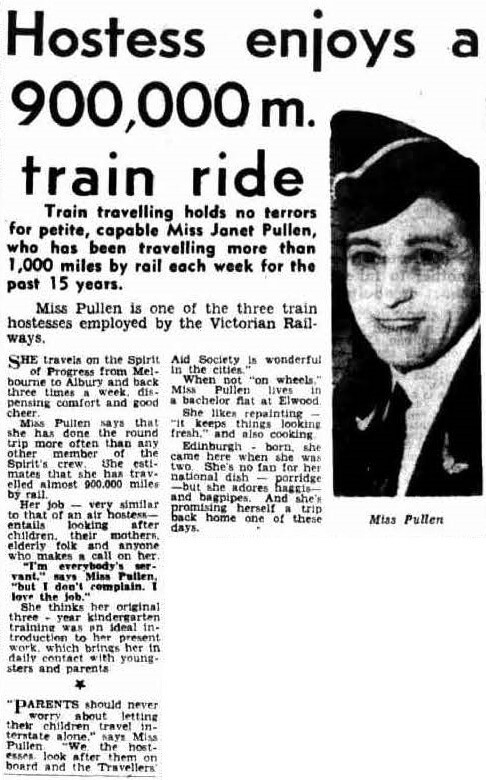The S Class Steam Locomotive No.302, the ‘Spirit of Progress’, 17 November 1937
Reproduced courtesy Public Record Office Victoria
Spirit of Progress in shed, c.1940
Reproduced courtesy Public Record Office Victoria
Making a daily return journey between Melbourne and Albury, the ‘Spirit of Progress’ was Australia’s first completely streamlined, air-conditioned, all-steel train. It went into service on 23 November 1937.
In a ‘normal year’s running’, the Spirit covered nearly 140,000 miles (225,000 kms) and carried over 200,000 passengers. More than 126,000 meals and 45,000 ‘serves of light refreshments’ were provided in the dining car. The 11 personnel on the train included locomotive crew, guard, conductor and refreshment services staff. An ‘obliging hostess’, or stewardess, was also on board – an innovation for Australian trains.
Melbourne Girl’s Job
In Melbourne there is a girl who walks 60 miles every week while she is travelling 1160. As the Spirit of Progress hurtles towards Albury, she (the train’s new stewardess) strides up and down the 600 feet of carriage corridor so many times that it is an underestimate to say she does a 10 miles hike each trip.
Miss Monica Hillman dismisses this effort with a wave of her capable hand. She is quite convinced she is the luckiest girls in the world, for she was the first to be chosen as stewardess from the refreshment room staff at Flinders-street station. Two years’ experience as waitress is, she says, just the sort of background needed for this job, unique in Australia’s train travel history. It makes you observant: it sends you up to customers — or passengers — to inquire what they want almost before they have thought of it themselves: above all, it makes you quick and deft, and gives you feet that can cope with any amount of work.
Miss Hillman does the return run to Albury three times a week; the other nights she is relieved by two junior stewardesses. When she is on duty, she boards the Spirit of Progress at the Dudley-street dining car depot, where the blue train is waiting, clean and fully equipped, for its journey across the State.
Soon after the train pulls into Spencer-street, Miss Hillman walks up and down the corridors, so that passengers will realise she is there to assist them and soothe away as many of their worries as she can. And once the whistle shrills and the journey starts, she continues with her vigilance work, never sitting down or resting until the Spirit of Progress reaches Albury.
“I try to give as much of my time to the second-class as to the first-class travellers”, she explains. “Mostly, I heat bottles for babies or I look after children while their parents are in the dining car. Sometimes I supply just the right shades of darning silk to mend ladders which have unexpectedly run up and down stockings.
Miss Hillman has been filling the role of stewardess since the Spirit of Progress’ maiden journey a month ago.
-The Dubbo Liberal and Macquarie Advocate, 17 February 1938
The Spirit of Progress was an impressive sight. The sitting carriages, dining car, van and locomotive were painted ‘royal blue’, with longitudinal parallel bands of gold. Built by Australian workers in the Newport Workshops (with more than 60 different occupations represented), the Spirit debuted many ‘firsts’ in Australian rail travel. Innovations included the train’s smooth ride, streamlined ‘Art-nouveau’ appearance and detailed finishings. It was a level of luxury never seen before in Australia.
The Spirit was the brainchild of Commissioner Harold Clapp. He was reportedly involved in every detail of its construction; even, it is suggested, allowing his wife Gertrude to name the train.
The Spirit of Progress ran for the last time on 2 August 1986.
The Spirit of Progress ‘on view’ at Spencer Street Station. This was probably the ‘open day’ on 20 November 1937.
Reproduced courtesy Public Record Office Victoria
‘The “Spirit of Progress” – New Express Ready for the Road’, The Argus, 17 November 1937
Reproduced courtesy National Library of Australia
Extract from article:
NEW EXPRESS READY FOR THE ROAD
VICTORIA'S STREAMLINED STEAM TRAIN
DETAILS OF RADICAL DESIGN WITHIN AND WITHOUT
To-day marks an epoch in the history of the Victorian Railways — the greatest business undertaking in the State, and the greatest single asset of its people. The "Spirit of Progress," the new Sydney express, is ready. Before the day has passed she will have completed her first official run, with honoured guests aboard.
Streamlining, air-conditioning, comfort, efficiency — all are combined in a train the like of which Australia has never seen before. In many features it leads the Empire, and the Empire is interested.
EVERYONE in the State has an idea of what the new train will look like as it steams into Spencer street station for its "launching" to-day, and then out again on the ceremonial run to Geelong. Its likeness has been on all the railway hoardings for weeks, the huge locomotive, Edward Henty, looming gigantic in the foreground, and the train of carriages stretching away like a ribbon of blue and gold against a green countryside.
Gone is the familiar funnel. Gone are the steam dome and the quaint little tangle of pipes and tubes that stood before the top of the driver's cab to make the engine whistle. There is not even the traditional round front with handles in the middle, or the platform above the buffers, with its two mysterious little gadgets standing swathed in sooty canvas. Even the buffers have gone.
In place of all these is a smooth, rounded front leaning backward a little from the vertical, as though restraining itself from the temptation to use all the tremendous power that seems locked within it. The great V.R. monogram flanked with wings spread for flight enhances the illusion. So does the huge Cyclopean eye set in the forehead of the monster…
When the eye has wandered over the vastness of the locomotive, and refused to take it all in, a miracle occurs. it sweeps down the long train of carriages unbroken, at first sight, by any gap or join. The great gold lines that gleamed on the sides of the locomotive wings sweep away across the blue into the distance, and the whole thing immediately assumes a grace that is difficult to reconcile with such huge size…
The exterior, austere, unbroken in line, with only the row of windows flush with the walls and the double line of gold along it, gives no hint of what lies within. It may be that the designers planned the contrast deliberately, for it is most effective. Through a flush door in the wall of blue-painted steel the passenger steps into an atmosphere of comfort. The air itself is different, as indeed it should be, for the results of years of scientific and engineering experience and experiment are embodied in the air-conditioning plant with which each carriage is fitted.
The floors are deep with carpeting — thick piled Axminsters and Wiltons. Beneath the carpet there is rubber linoleum. Beneath that again is a layer of sponge rubber; then wood fibre board: then a thick layer of cork to cover the grooved Corten steel. Then hair felt, and a sheet of aluminium. It seems as complicated a floor as ever was made; it is designed to exclude all noise, all jarring, and all vibration.
It is, in addition, an effective barrier to heat in both directions. In winter, the floor cannot become cold: in summer, it cannot become hotter than the cool conditioned air which will circulate through every part of the train. But all the passenger sees of it is the yielding carpet, edged with rubber skirtings which effectively protect the polished wood panel walls from scratches.
Walls and ceilings are insulated similarly. Inside the shell of each carriage there is a layer of soundproof felting, cemented to the steel. Crinkled aluminium foil reduces the heat transference in the roof, and in the walls its place is taken by insulating sheets cemented to the felt. The inside finish is of panels of Australian timber in beautiful shades and figuring. Every corner is rounded, and the joinery excites admiration for the workmen who did it.
Seats are upholstered in chrome leather to harmonise with the carpets, and there is a pleasing variety throughout the train. In the first class non-smoking compartments the leather of the seats is dark blue, the carpet is dark brown Saxony Wilton, and the walls are of Queensland ribbon walnut. The ladies' compartments have light grey chrome leather seats, pastel green carpet, and panels of Queensland Royal walnut. The scheme for the smoking compartment includes Queensland flowery walnut and West Australian jarrah, rich plum red leather, and a carpet of dark blue.
The materials and construction of the second class compartments are identical with those of the first class, except that the colourings are different. The only significant difference between the accommodation in the two classes is that four persons will sit on each side of the second class compartment, with folding arm-rests dividing the seats into two sections, while in the first class the same space will be occupied by only three passengers on each side, with a folding arm- rest on each side of each passenger.
Luggage racks have rubber-covered front bars to prevent luggage from slipping, and chromium-plated fillets against the wall protect the woodwork from scratching and enhance the appearance of the interior decoration.
The windows are large and wide, framing the scene without. They are double to prevent the conduction of heat, and they are of unshatterable glass affording complete protection in any emergency. Each compartment has its card table stored under the seat in a little locker, and the fronts of the seats come straight down to the floor, leaving no harbour for rubbish.
It is in the parlour car that comfort reaches its climax... From within, as from outside, the rounded end of the tail of the train is completely pleasing to see. Most of the walls are glass — double glass, with an insulating space between, so that the windows need not become hot, even on the hottest day. It is an observation car, built for observation, and as the train travels the State each window will frame an ever-changing view of countryside, fields, homesteads, mountains, and streams.
Should the glare of the sun be too trying, each window in the observation car has its Venetian blind which may be drawn down and adjusted to individual comfort.
It is the furniture in the parlour car, however, and its disposition which give the most telling impression of comfort. The car is furnished like the sitting room in a private home, with lounge chairs, couches, and settees of varying types and in a harmonising variety of upholstery. Fawn, blue, and pastel green pin-weave tapestries are used for the upholstery. The internal panelling is of Australian blackwood, and the carpet is a glorious piece of work in old gold. Indirect lighting reflected from a slightly green-toned celling is supplemented by two table lamps on the book cabinets. The compartment has accommodation for l8 passengers.
Behind the observation room is a smoking compartment furnished with full leather lounge chairs — the sort into which into one sinks and cannot tell when the sinking ceased, so kind are they to the sitter. The chairs are upholstered in dark green chrome leather… The panelling in this section is of Australian cedar.
As unlike a conventional railway carriage as anything on wheels could be, this observation car on the "Spirit of Progress" has been designed and furnished for homely comfort.
NOVEL SYSTEM OF INTERIOR LIGHTING
VICTORIAN railways led the British Empire in air-conditioning. Now it seems that they will provide a lead in train lighting also. The co-operation of illumination experts from the State Electricity Commission was sought in designing the lights for the "Spirit of Progress". The train is not yet running, but the success achieved in the design of this feature is so marked that news of it has already travelled across the world, and the Victorian Railways Commissioners have received requests from railway authorities in Great Britain for details. In contrast to the great glaring eye on the front of the locomotive, which sends its beam for miles across the countryside through the night, not a light is visible in the interior of the train.
The centre of the roof in each compartment has a disc of opaque glass just below the ceiling, with an inverted metal dome in its centre. This is the lamp fitting. Between it and the curved ceiling a concealed lamp spreads its rays to illuminate the whole compartment with a uniformly soft white glow. For reading, writing, or sewing there is an additional lamp for each passenger, operated by individual switches. Should one passenger desire to read and the rest to sleep, he may light his own lamp to shine over his shoulder directly on to the book, and all the other lights may be extinguished.
Women working in the kitchen on board the Spirit of Progress, c.1940
Reproduced courtesy Public Record Office Victoria
The Spirit boasted a modern galley kitchen, comparable to those seen only in hospitals at the time. It was reported in The Argus:
The kitchen is a symphony in stain-less steel — stainless steel walls, range, cup- boards, and sinks, red ironite floor with carborundum cast in it to prevent slipping, and slow combustion coke burning ovens and stoves. A unique system of air circulation makes the kitchen comfort-able for those who will work in it, and prevents the escape of cooking odours into the dining saloon of the car.
Spirit of Progress menu, produced by Victorian Railways, c.1937
Reproduced courtesy State Library Victoria
Dining car, Spirit of Progress, by Victorian Railways, photographer, c.1945
Reproduced courtesy State Library Victoria
1st class compartment, Spirit of Progress, c.1945
Reproduced courtesy State Library Victoria
TRIBUTES TO ARTISANS.
Before the “Spirit of Progress” left Spencer-street station yesterday morning the Premier (Mr. Dunstan) Christened the train and opened the door of the parlor observation car with a gold key.
The Chairman of Commissioners (Mr. Clapp), introducing the Premier, said the new train was a great achievement, and its launching would go down in the history of the Victorian railways. Constructed entirely by Australian workmen at the Newport railway workshops, mostly from Australian materials, the train was a distinct step forward in railroading in Australasia. The men and women associated with the construction of the train had worked earnestly and loyally. Not only was it the finest train in the southern hemisphere, but it ranked equal to the most modern trains in the world.
The Premier (Dr. Dunstan) drew a comparison between the “dog-box” carriages of a few years ago, with the luxurious accommodation provided in the “Spirit of Progress” to illustrate the remarkable progress that has been made in train construction. The train was the Railway Commissioners’ answer to the challenge from road and air competition…
Not only was the train a living embodiment of the State’s progress and a triumph of Australian workmanship, but it represented a great contribution by Mr. Clapp to the life of the State. The train stood for the ideals of railway service — efficiency and up-to-date service.
‘“Spirit of Progress”. Premier Christens Train.’, The Age, 18 November 1937. Reproduced courtesy National Library of Australia.
Miss Pullen is one of the three train hostesses employed by the Victorian Railways.
She travels on the Spirit of Progress from Melbourne to Albury and back three times a week, dispensing comfort and good cheer.
Miss Pullen says that she has done the round trip more often than any other member of the Spirit’s crew. She estimates that she has travelled almost 900,000 miles by rail.
Her job — very similar to that of an air hostess — entails looking after children, their mothers, elderly folk and anyone who makes a call on her.
“I’m everybody’s servant”, says Miss Pullen, “but I don’t complain. I love the job.”
-The Herald, 9 September 1953

